The drive from Liverpool to Manchester is suitably bleak. Not an unusual occurrence (even for a Saturday afternoon), with the rain coming in at right angles, and approaching the city center, traffic is at gridlock thanks to seventy-thousand football supporters spewing out of Old Trafford.
It’s a perfect storm and one that I would imagine forms the backdrop to a Bonnacons of Doom song, who themselves have had their own treacherous journey on this day – a much longer commute following their show the night before in Bristol supporting Pig Pigs Pig Pigs Pigs Pig Pigs. Their latest show on this run of dates sees them share the stage of the O2 Ritz with the Geordie Black Sabbath worshipers.
Barely on time and through the venue’s doors, the crunching groans of Lichen ring from the stage. The penultimate track from Bonnacons of Doom’s excellent new album Signs, the set is dotted with songs both new and old. Another new one, the eponymous track is pitted against the arctic blast of Esus, which then bleeds into the seminal closer, Argenta – undoubtedly the hallmark moment that crystalises the transpennine hypnotics this band is known for.
Navigating in and around her masked bandmates, vocalist Kate Smith orchestrates the show with a vocal range few others in the doom broadchurch can match. A wicked brew of operatic chants and screams, Smith’s voice soars above the sea of guitars and crushing bass weight her fellow Bonnacons conjure up. The performance, purely transcendental.
And it continues on Signs, the much anticipated follow-up to the band’s 2018 self-titled debut LP. Recorded at Whatstudio by Stephen Cole and mixed by Sam Weaver, Signs sees Bonnacons of Doom continue to guide us through their mystical sound world. Led by Smith’s grandiose shrieks and howls, it’s an album delivered with boundless prestige.
Starting with the celestial rush of lead single, Facing, we see Smith riding into the eye of the storm. So too with the dynamic rework of Esus – whilst always risky re-treading over the past, this version feels like it takes on new meaning.
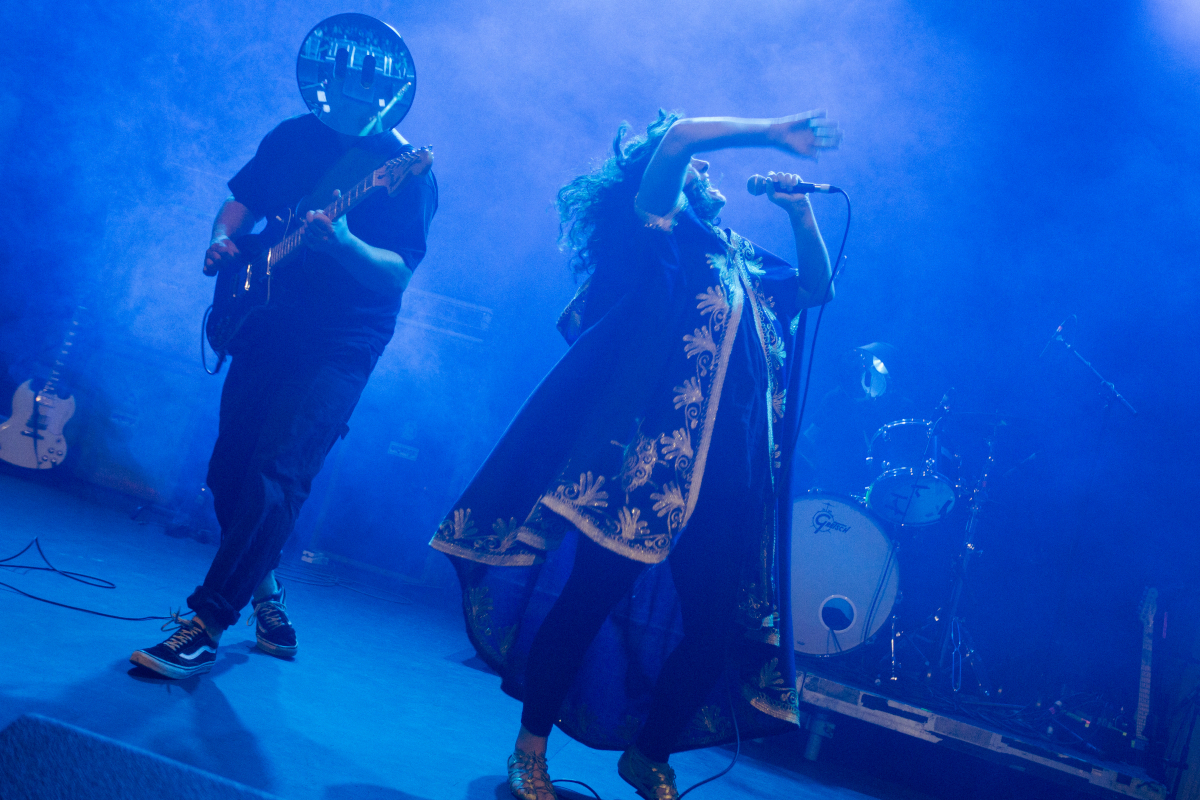
Bonnacons of Doom (photo: Jamie McMillian)And speaking of, it’s the slower side to Signs which may provide the crucial talking points. Starting with Infra – A beautiful blur of slow-motion electronica with melodies that inject a new energy into the world of sound design. Continuing this sonic shift is the trance-y title track, while closing cut, Semaphore, is a frozen stare into the abyss. A song that echoes the dread of Mezzanine-era Massive Attack.
Against these slick new multi-faceted soundscapes, the band still manage to dispense their staple roaring pillars of scorn. Take the galvanising lightning bolt of Limina and Lichen. Blocks of white noise that light up the darkest tunnels of psychedelia.
Undoubtedly, Signs is one of the year’s finest journeys across the haunting terrains of doom and alt-metal, and another vital thread to the Rocket Recordings patchwork.
In a pub around the corner from the band’s regular haunt of Sort Rehearsal Rooms, in the lead up to the release of Signs, I caught up with Kate Smith, guitarists Rob Strachan and Alan Sundvall, bassist James Binary and drummer Sam Wiehl (also the visual artist responsible for the album artwork and the video for lead single, Facing).
While multi-instrumentalist Simon Stafford is absent, the interview still marks a first for the band: this is said to be their inaugural ‘group’ interview, and with it they are more than happy to disclose their names.
Sun 13: You’ve just finished up a tour with Pigs Pigs Pigs Pigs Pigs Pigs Pigs. How did that go?
James Binary: “It was great.”
Al Sundvall: “It was a sympathetic audience.”
JB: “Sympathetic?” (laughs)
AS: “I mean, sometimes you’re fighting to convince people. It wasn’t like that. They knew we were labelmates with Pigs, or they were open to what we were doing.”
Robert Strachan: “Also, with Glasgow first off, we thought, ‘Okay, early stage time, we’ll all kind of work it out’. But people were dead into it. And then Bristol has always been receptive. We play Bristol much more than Liverpool; it just seems like somewhere that’s really open to us. Just in terms of playing with [Pigs], a band who are clearly on an upward trajectory was amazing. You could see they were on fire.”
Sam Wiehl: “We hadn’t done a tour, or a consecutive number of dates for a long time. We started to get to grips with playing live again. And we’ve got new masks, which has made a massive difference to communicate on stage. It’s been an issue before, and we’ve somehow managed to get through that.”
Kate Smith: (Laughs) “It has!”
RS: “Because they were, like, really DIY before, weren’t they?”
SW: “We’ve had actual road traffic mirrors. (laughs) I think in general it was really enjoyable to play onstage together. I think the actual performances, I think everyone really got into it. It was very nice to do.”
KS: “It was so great to play live again and to do a number of gigs. Not just one-offs, so we could really settle into it – a chance to work on our craft!”
RS: “It’s the first time we’ve done a concentrated number of dates together since before lockdown. We haven’t had a record out to promote. That cycle took us two years of touring and then COVID happened. We were halfway through an album before COVID… and then it just didn’t seem right what we’d done when we came out at the other end. So, it’s been a little bit intermittent.”
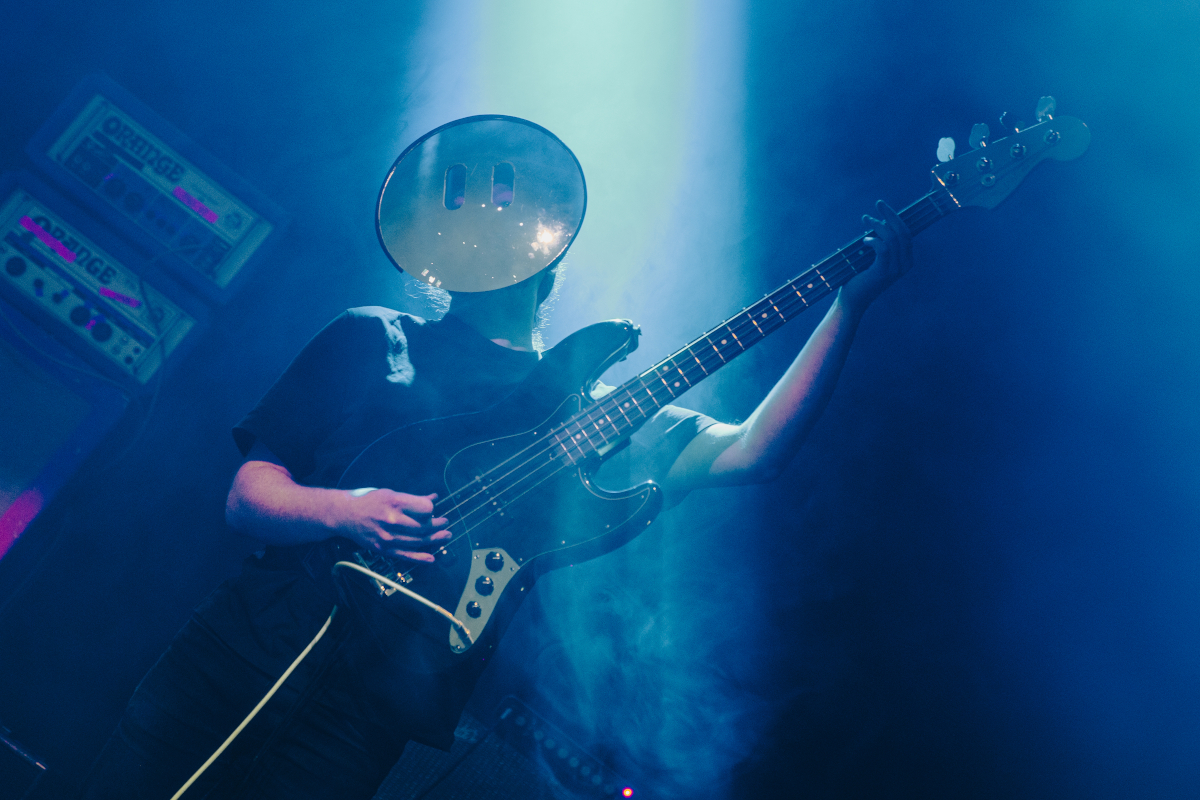
Bonnacons of Doom (photo: Jamie McMillian)S13: Can you tell us about the process behind Signs?
SW: “It’s good point about the fact that we’ve written a lot of material that we presumed was going to be the second record… and for some reason, we came back out of COVID, it didn’t seem where we were all at. I think there was an element of it sounded quite upbeat, and quite pop. And I think we all were a bit like, ‘Hang on a second. The way the world is and the way everything feels now, I don’t feel like this’.”
JB: “Do you think that?”
SW: “We might have talked before everything happened. Maybe it went through a bit of a cycle, but certainly with some new stuff at the time, we were much heavier and doomier.”
RS: “Facing was written at that point, but the way that it’s ended up on the record is a lot more gnarly and angry than it was. I certainly liked the electronic stuff, two of the three electronic songs [are] quite dark. But also, in terms of the writing process, whatever we had around in terms of just slightly electronic stuff is a natural progression. I’ve always done electronic music in different incarnations.”
SW: “Bonnacons concepts with varying levels of electronics.”
JB: “We’ve had a three-member change between records.”
RS: “[From] the second half of touring the first record, so you were part of that process. By 2019, the line-up changed already. We were playing it out as a live thing.”
JB: “Yeah.”
AS: “That was the thing early doors – it was an actual fluid lineup. That’s why the masks helped… we would talk about having a quorum for the bare minimum number of members to pull off a gig.”
JB: “Simon was on the first album playing trombone. Then he’s become more central to that process. We toured Europe twice without him being there because it was fluid, but now I don’t think we could do that, as he plays keyboards and the Taishōgoto. It’s like, ‘Put a mask on’.”
SW: “Again, going back from where it all began, it was never going to be any recorded music from the band. It was always going to be an installation. Everything was going to be a one off, so the more it’s gone on to be a solid band, that’s taken a period of time. That’s the organic and fluidity, not like a decision was made that we’ll do one or the other.”
KS: “That’s how I came along! They’d just done something at Psych Fest with multiple drummers. Rob had asked me to sing, I was going to do vocals for another one off. We jammed Argenta that night and wrote it then and there. Plantae followed just after. I performed that first gig at Supernormal in the woods singing those two songs and drumming on Rhizome, ha! It was one of my favourite gigs! It worked, I guess (laughs), because we became a band and went on to do the first album. Then Simon came on the trombone!”
S13: Talking about Simon, the Taishōgoto is central on Limina.
RS: “Yeah, he plays bits of that throughout the album. It’s something we can’t replicate, so it’s more of like Sam was saying, it’s become more of a unit lineup. It’s not interchangeable.”
S13: Talking about the conceptual basis of the band, as Kate doesn’t wear a mask, how much pressure is that as the singer?
KS: “I feel a lot of pressure (laughs). There’s always an element of pressure as the singer but being the only one un-masked definitely adds more responsibility.”
JB: “It was really apparent when we were doing our show and then you were doing the Pigs show. So, you’d have to do two performances. You were Bonnacons, then you were Kate from Bonnacons. Because obviously we can’t see it from front on, it was the first time we’ve ever seen you before, which was amazing.”
KS: (Laughs)
AS: “It’s the theatre of it.”
JB: “We are high theatre.”
KS: “I don’t know.”
SW: “The concept of it being an art project to begin with and the masks were a cymbal of that cultish ritual… British folklore, we liked all this stuff. The mask became a visual symbol, it’s on all the record sleeves, our merchandise.”
S13: You do carry a mystique onstage, though. For example, you don’t communicate with the audience during songs.
KS: (Laughs)
AS: “I do sometimes think… imagine if Kate said, ‘Merch for sale down the back’.”
(All laugh)
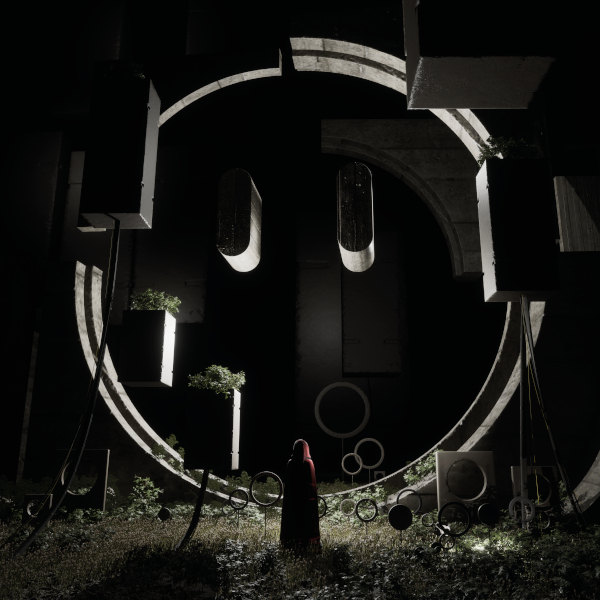
Bonnacons of Doom - SignsS13: Talking about British folklore because in this New Weird Britain movement over the last 10 to 15 years, you’ve had Richard Dawson and more recently Keeley Forsyth… I never really had your band in there, but now you mention it makes so much sense. Is that something you’ve thought about over the years?
RS: “I think we probably did in terms of the way we were talking about the process. I think process is an undervalued thing about being in the band. The process is really important for all of us, in terms of that it’s something that we do every week. When there’s a moment when it kicks off, and my favourite moments are when something just happens, right? I don’t know that it’s the kind of communication between different people.”
JB: “Don’t all bands do that?”
RS: “The stuff that we do, when it goes off and it becomes something else, that feels really intense. And it’s not because it’s not so phased in. The process is jamming and playing the same thing over and over again.”
JB: “It definitely feels amazing. I just thought it was commonplace, the jamming thing.”
AS: “Not every band does that. Someone writes the tunes, and everyone else comes in and learns the tunes.”
S13: What about in terms of someone bringing in a core idea. Simon’s part in Limina feels like one of those moments, that key thread throughout the song.
KS: “I think that started as a guitar riff.”
JB: “That’s how it all starts. Every single one.”
S13: With tracks like Signs and Semaphore, were you worried that some of your audience that prefer the doom-based material would be put off by the more electronic-based songs?
SW: “We all listen to loads. I don’t think taking different influences and lots of different things is particularly unusual. But I think we’re all really into electronic music, so it does make sense. Our backgrounds have been working in electronic music. Kate’s background, Rob and I, James’s have all been involved with electronic projects. So, it’d seem strange for that not to be a part of this.”
RS: “The stuff we’d done before, like the EP that came out on the Psych Fest label, that was pretty eclectic… and then Sam was doing visuals for a promotion, and I did some music; that came out as an EP as well. It was more industrial based, rolling, harsher electronics and stuff. We’ve always done that.”
S13: Those collections on Bandcamp… personally that is the introduction into Bonnacons. It’s got everything…
RS: “Yeah, in terms of audience, with post-digital and post-streaming, where people draw stuff from everywhere.”
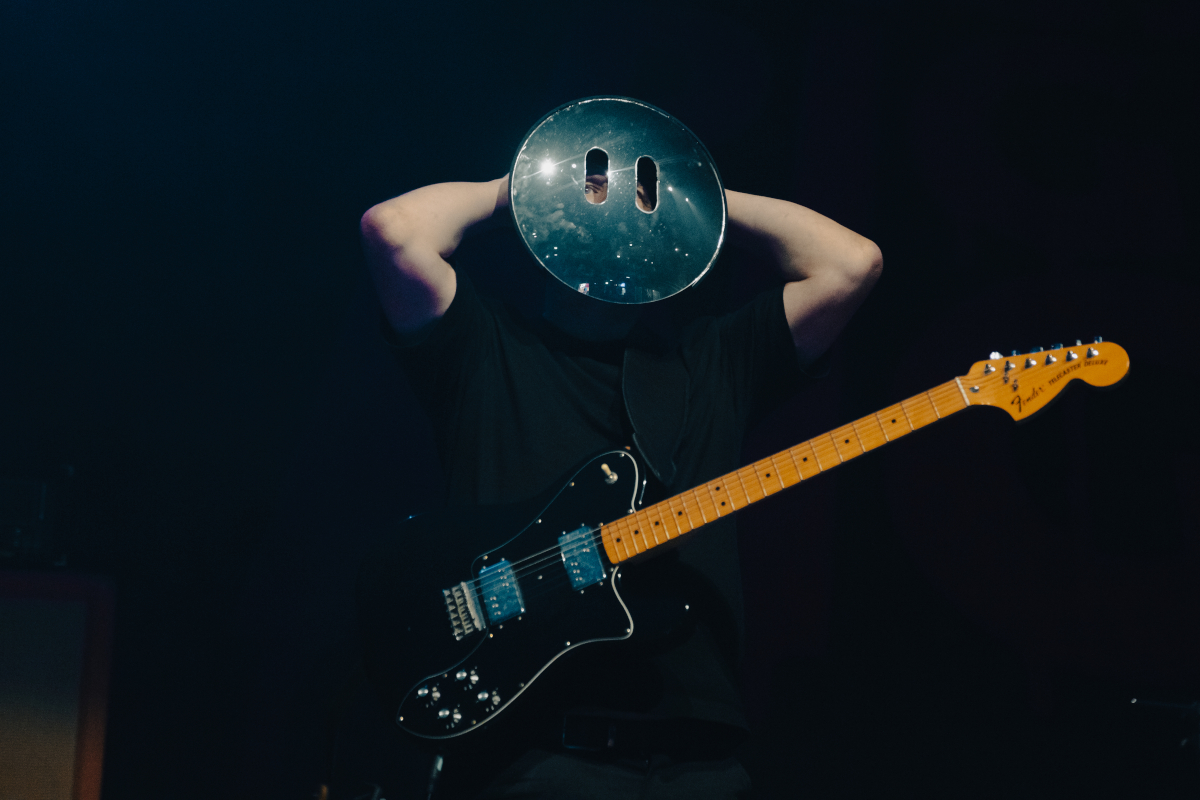
Bonnacons of Doom (photo: Jamie McMillian)S13: In the press release, you were talking about post-digital decay being a heavy influence on this record.
RS: “What we were saying before about wanting to make a darker record because COVID had happened, and the world is fucked and people are getting their information from weird sources and interpreting in weird ways, which is infuriating. In terms of people talking backwards and forwards to each other, it just doesn’t make any sense. Everything seems fractured, people are going and grabbing things and going down rabbit holes. It’s dark.”
SW: “It came out of a dark period, but we haven’t made a record that’s somehow meant to be bleak. I don’t think we’d do that; we’re not those type of people. We are more interested in having a great time and really being in the zone and being whipped up into that zone. We always talk about acid house culture, and the type of music that we’ve all been into is in the face of dark times.”
JB: “There’s all this transcendental black metal now, too, which is obviously brilliant. It’s just like reframing something.”
AS: “That side of it, obviously our output is two albums in five years… and then the gigs. Lockdown aside, we’re in that rehearsal room every Thursday. It’s our social life. It’s a deep friendship. So even if we go there and nothing comes out of it, or we go there and just get pissed, we’re there week-in-week-out jamming.
“The band fulfills a lot of different roles. We love playing gigs, and we love the process of making music. But more than that, there’s a deep connection that just comes from these six people getting together every week, week-in-week-out and jamming, whether anything comes out of it or not.
“When we play live, we may feel like we’ve had a good gig or a bad gig, but for me, often it’s like this continuum where we’ve been jamming together so consistently that it’s just peaks and troughs. A bad gig is just a low point in this never-ending thing that we’re pursuing.”
SW: “It’s an emotional process. Probably too much in a way. It’s a vital thing I really want in my life.”
KS: “Absolutely. I definitely need to express myself creatively. I’m compelled (laughs) to write music and sing and perform.”
AS: “For a hobby band or a part time band; obviously we take this seriously. We’re on a great label, there’s an audience, but it’s not easy. Another thing about the Pigs tour is the logistics of being in a six-piece rock band in the year 2023 is really fucking difficult and expensive. So, it’s a labor of love, but you wouldn’t do it if you didn’t believe in it.
“I often think of Jo [Thompson] from Hey Colossus’ book, which is a wonderful insight into what it is to be in a band for the some of the same reasons that we’re in a band. Sometimes it’s hard to articulate to other people. For example – I’m forever getting guitar pedals delivered to my house and I happened to let slip to the postman that I’d just gone on tour. So now he likes to joke about when I ‘make it’. Obviously he means well, but I don’t want to ‘make it’! I’m very happy with this being a means to an end; I’m already getting enough out of it. The band is its’ own reward. Sure, we could get paid some more money (or at least not lose money) and more people could come to see us play, but apart from that, all the boxes are ticked for me.”
RS: “An album is a funny thing by that it’s an end product of what Al’s just been talking about. But that process is the thing that’s important to us. Having an outcome and wanting to make a good record, but also, it’s an endpoint to the shit that we’ve been doing on a day-to-day basis, which is a really important part of our lives. An album enables us to do other things that led us to go on tour, but essentially, it’s a snapshot of what we have been doing and that’s why it’s difficult to do.”
JB: “I find it almost frustrating… while it justifies the project, because otherwise, you know, all our partners would probably be like, ‘What are you doing?’ (laughs), it’s just 42 minutes. It’s a reduced version of five years, four hours a week.”
AS: “Without lockdown, it didn’t take us five years to write the record. Maybe three.”
JB: “Maybe it took me a year to convince some of the riffs, but 800 hours condensed to 42 minutes. That’s what we show people, and I find that really weird.”
KS: “Yes, I find that weird. Out of all the rehearsals, all the riffs, all the tunes, the time shared together, to condense it to an album and say that’s it – this is a summary of it all!” (laughs)
SW: “Even the takes of those tracks. Even though we rehearse and chat, they’re always going to be slightly differently. There’s always a process to decide which one is the one. It’s never really going to be the point of the band. We’ve got to do that to make records. We have done a version of a song that might have gone on for five or 10 more minutes than it should have done, but actually, that might have been incredible, but we didn’t record that one.”
JB: “That rounds out the point there. We could do many takes of the same thing. But ultimately, that is what us and our label have put out to the universe, and it’s a very, very strange thing to do. Because previously we’re like a Gestalt entity of many members… and now we’ve got this iconography of the masks, and now we’ve got this folklore attached to ourselves, and it’s really detached from us as individuals. That is more of an objective as a group. It’s a really weird calling card, because obviously the shows are well different. Because there’s no theater of listening to the record at home. And then you’re presented with us and how we chose to walk onstage.”
SW: “Again, this goes slightly into the idea that we were thinking about making the next record a lot quicker than we have made this one. To make this one almost in two or three more years before we get the next one out, I think that we all love to be a bit freer. Like, ‘Okay these bunch of tracks, they’re out, and then another bunch are out’. I think that’d be quite true to ourselves to move like that. We’re already thinking about the next one that might, for ourselves, be truer to what the project is.”
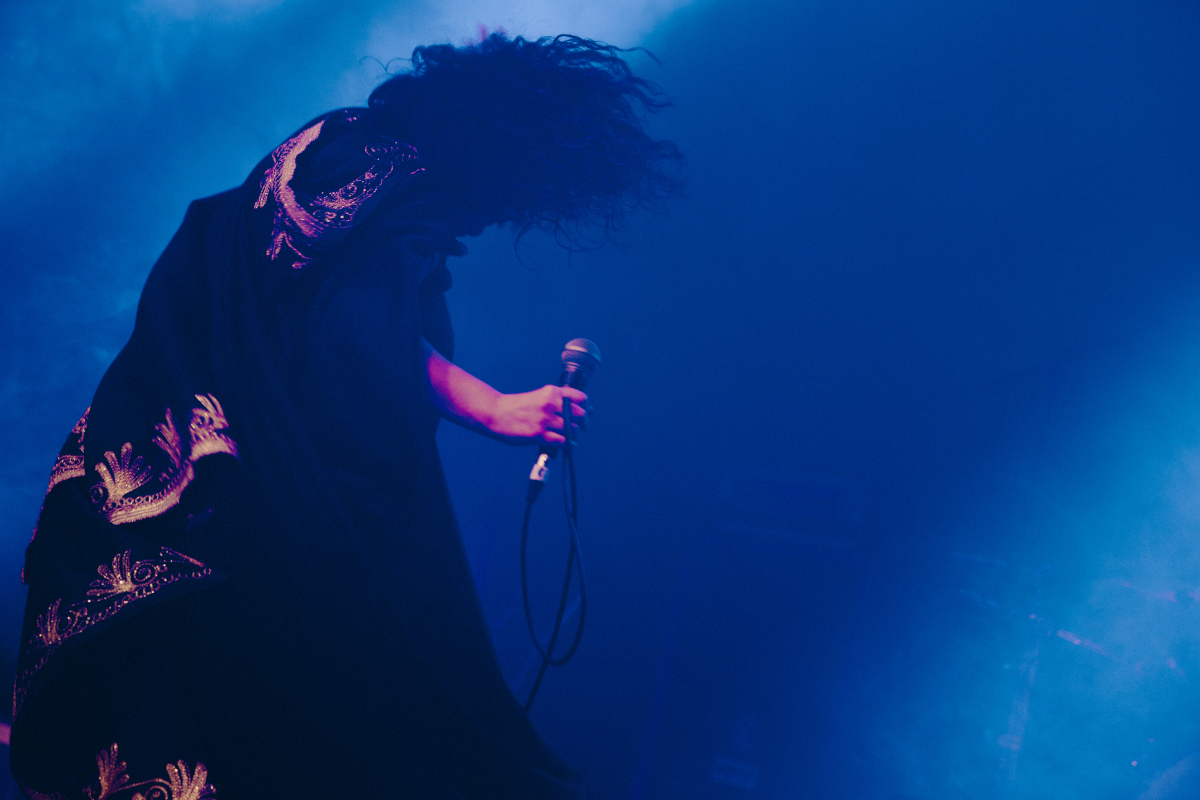
Bonnacons of Doom (photo: Jamie McMillian)S13: How much creative tension is among six people, and if there is, does it make the whole experience better?
AS: “Everyone has to have thick skin.”
S13: Compromise?
AS: “Of course, it’s compromise.”
SW: “Also, we’re quite good at knowing each other and what we’re going to like.”
RS: “I think with the electronic stuff, [looking at Kate] you felt quite exposed because it’s more sparse.”
KS: “Yeah, it felt very different to do that with us in this band, where things have been purposefully more wordless…sounds, vowels, and often mixed within the instruments, or shrouded in reverb and delay. Although I’ve written and performed in this way, I think it initially felt really incongruous with us to use a more traditional song approach and to be heard clearly rather than something that is fleeting or unknowing.”
RS: “The two electronic tracks that aren’t Signs [Infra and Semaphore] are really amazing in terms of like, you’re really worried about them because of being completely feeling exposed in terms of that environment. But actually, I think that’s what makes them! I think they’re really emotionally engaged… and then suddenly that’s the other side to the reason.”
KS: “Right.”
SW: “I mean, Kate is unique.”
KS: “Stop it!” (laughs)
SW: “Whatever we do we get to have Kate sing over it, which is a big thing. We know that we can do what the hell we want with that track because Kate can give a vast array of different sounds, experiences for the listener.”
S13: You were writing lyrics the day you were going into a recording session. Is that a standard approach?
KS: “Yes and no. I usually approach all my writing in the same way, in that I sing out the melody straight away. The first thing that comes to me when I hear the riff or chord progression and that can be sounds, vowels, or something with an amount of syllables. Sometimes those sounds will stay with the melody, then I can build more lyrical things around it. But sometimes they can come out formed.
“For example, Semaphore came out straight away. That came out formed, whereas Limina was just sounds and syllables, which I wrote the words around. With Lichen, a more traditionally ‘us’ track, there’s actual lyrics, which is a progression from the first album. I wanted to mix all the ethereal high notes and the raging wordless sections with some lyrics this time and explore that, I guess. To use a full range and spectrum of my voice.”
RS: “Like when we’re jamming and you’ll just have an immediate response to something that stays and elevates. Quite often there’ll be a riff, and you’ll find a melody clear. But also sonically, some sounds will stay there, just from that process, and it’s like, ‘Shit, that’s cool’.”
S13: With the recent news on Bandcamp, it also feeds into that idea of post-digital decay. It’s another clear example of tech having little care for art…
RS: “That’s the way that business models work, right? Bandcamp was always going to be bought out. It was like a moment when it lasted. Fuck knows what’s going happen next.”
AS: “It was profitable and it worked, and the first company that bought it didn’t fuck it up but then they sold it to another company who immediately fucked it up.”
RS: “It’s the logic of capitalism. Companies like that are put in a position where that’s just what you do. This is the logic of big tech when you get to that level. It was like everybody who interacts with it was like a class that was a community and it worked for hundreds of thousands of people. The thing about Bandcamp is that it was essentially a central thing. It was platform capitalism which actually spoke to a community but the nature of it just meant that it’s inevitable. Like a fucking trick.”
Signs if out now via Rocket Recordings. Purchase from Bandcamp.
Presented by Harvest Sun, Bonnacons of Doom play Liverpool’s Quarry tomorrow night. Purchase tickets here.

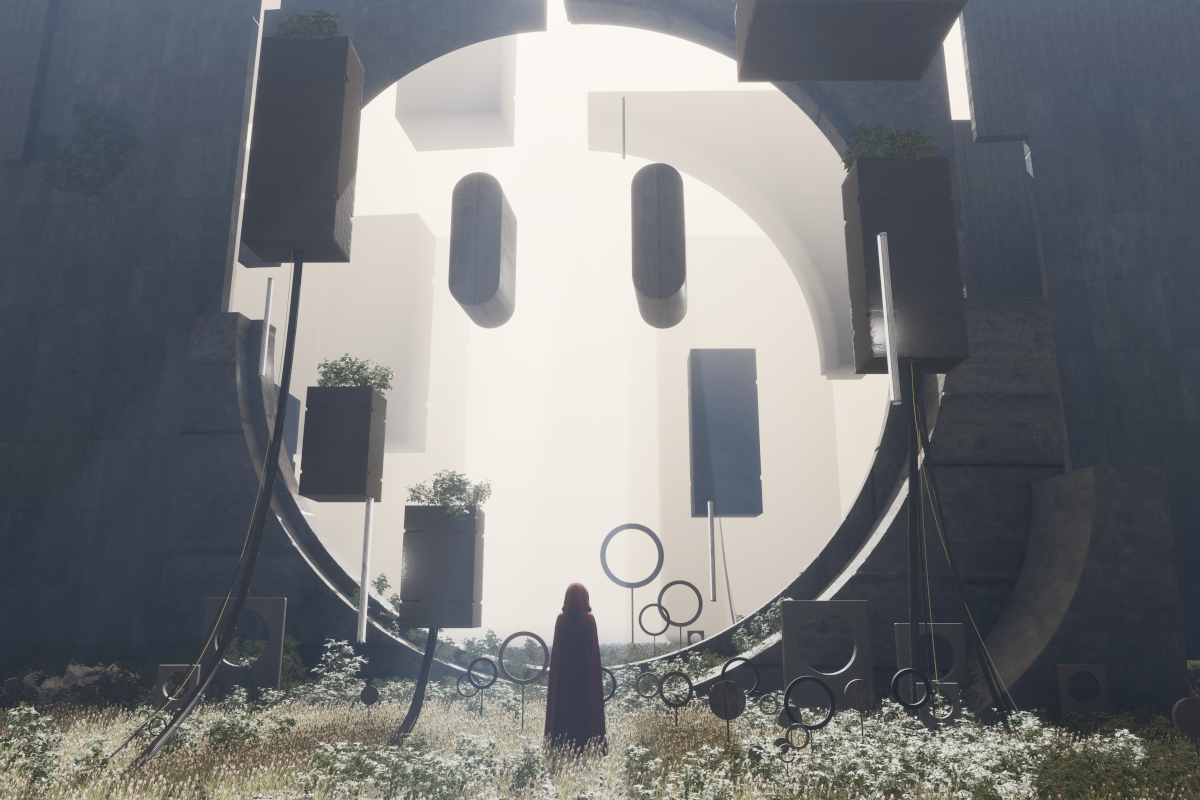
9 replies on “Behind the Masks: In Conversation with Bonnacons of Doom”
[…] In Conversation with Bonnacons of Doom […]
LikeLike
[…] new releases from Crime & The City Solution, Bonnacons of Doom, ChiaraOscuro, Jayve Montgomery and All Structures Align have been among those that have been hard […]
LikeLike
[…] in various projects over the years (most notably Eyes, the experimental collective that included Bonnacons of Doom’s Sam Wiehl), under the Kepla guise, Davies has never made the same record […]
LikeLike
[…] Boris’ Pink, and for those also yearning to remain in the sound world creating someone like, say, Bonnacons of Doom, it’s essential to follow up their latest record, Signs, with this. […]
LikeLike
[…] As always, Wolfe shifts sonically with the grace of a warm spirit. On House of Self-Undoing, there’s a mystique that sees her moving away from her alt-metal allies to the transcendental sonics of kindred spirits in wait, Bonnacons of Doom. […]
LikeLike
[…] Dala Studios Winterthur by David Langhard and mastered by Total Control’s Mikey Young (UV Race, Bonnacons of Doom et al), lo tu il loro pulses and undulates with the kind of wonky sonics that are like a backdrop […]
LikeLike
[…] at Dala Studios Winterthur by David Langhard with mastering duties falling to Mikey Young (UV Race, Bonnacons of Doom and guitarist for Eddy Current Suppression Ring and Total Control). The results are warm, tender […]
LikeLike
[…] Behind the Masks: In Conversation with Bonnacons of Doom […]
LikeLike
[…] Which is where Life Will Wait comes into the equation, but perhaps not in space. Featuring Pigs x 7’s Adam Skyes, this is cult-like campfire doom that escapes the clutches of a modern reality, with Ashleigh’s harmonies echoing the séance-like transcendence of Bonnacons of Doom. […]
LikeLike